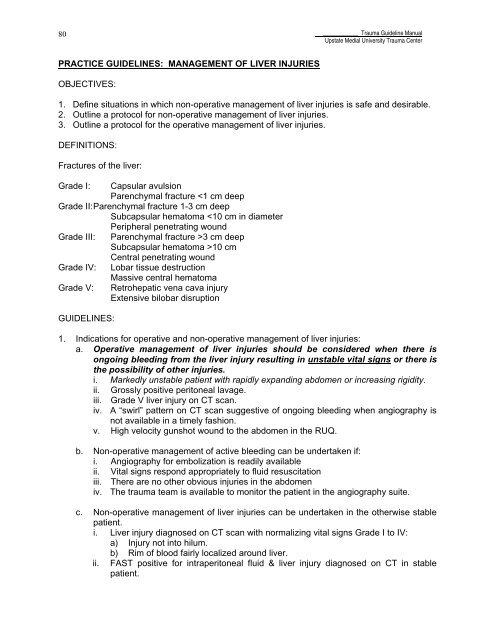Trauma Guideline Manual - SUNY Upstate Medical University
Trauma Guideline Manual - SUNY Upstate Medical University
Trauma Guideline Manual - SUNY Upstate Medical University
You also want an ePaper? Increase the reach of your titles
YUMPU automatically turns print PDFs into web optimized ePapers that Google loves.
80____________ <strong>Trauma</strong> <strong>Guideline</strong> <strong>Manual</strong><strong>Upstate</strong> Medial <strong>University</strong> <strong>Trauma</strong> CenterPRACTICE GUIDELINES: MANAGEMENT OF LIVER INJURIESOBJECTIVES:1. Define situations in which non-operative management of liver injuries is safe and desirable.2. Outline a protocol for non-operative management of liver injuries.3. Outline a protocol for the operative management of liver injuries.DEFINITIONS:Fractures of the liver:Grade I: Capsular avulsionParenchymal fracture 10 cmCentral penetrating woundGrade IV: Lobar tissue destructionMassive central hematomaGrade V: Retrohepatic vena cava injuryExtensive bilobar disruptionGUIDELINES:1. Indications for operative and non-operative management of liver injuries:a. Operative management of liver injuries should be considered when there isongoing bleeding from the liver injury resulting in unstable vital signs or there isthe possibility of other injuries.i. Markedly unstable patient with rapidly expanding abdomen or increasing rigidity.ii. Grossly positive peritoneal lavage.iii. Grade V liver injury on CT scan.iv. A “swirl” pattern on CT scan suggestive of ongoing bleeding when angiography isnot available in a timely fashion.v. High velocity gunshot wound to the abdomen in the RUQ.b. Non-operative management of active bleeding can be undertaken if:i. Angiography for embolization is readily availableii. Vital signs respond appropriately to fluid resuscitationiii. There are no other obvious injuries in the abdomeniv. The trauma team is available to monitor the patient in the angiography suite.c. Non-operative management of liver injuries can be undertaken in the otherwise stablepatient.i. Liver injury diagnosed on CT scan with normalizing vital signs Grade I to IV:a) Injury not into hilum.b) Rim of blood fairly localized around liver.ii. FAST positive for intraperitoneal fluid & liver injury diagnosed on CT in stablepatient.
















